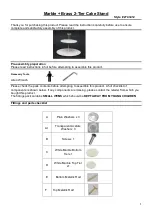
– 67 –
6 CLEANING AND MAINTENANCE
Follow all instructions described in the Safety
chapter
Before cleaning, check the cooking plate has been
fully switched off and the glass above the cooking
zones has cooled down.
Follow the cleaning instructions below for a long life
and optimum functioning of the device.
6.1 Maintenance of the hob
First let the device cool down, otherwise there is a
risk of burns.
Never use “steam” or “pressure” equipment.
Never use objects that could damage the vitro-
ceramic glass such as an abrasive sponge, abrasive
cleaning liquid or aggressive cleaning agents.
Clean the glass of the cooking plate
Wipe the surface clean with some washing-up liquid on a
damp cloth or sponge (it is best to do this after every use), then
dry the hob by rubbing with a dry cloth or with kitchen paper.
Always make sure that all cloths used are clean in order to avoid
scratching the surface.
In case of stubborn stains
Heavy contamination and stains (limescale stains, pearl-
like shiny spots) are best removed while the hob is still
warm. For this apply common cleaning agents and cleaning
methods. If this does not work well enough, you can use a
specific cleaning product for cleaning vitro-ceramic glass
(for example, Vitroclen)
Boiled-over food should first be soaked with a wet cloth; the
contamination residues should then be removed with a glass
scraper that is specially designed for ceramic hobs. After this,
clean the hob as described under “Cleaning glass hob”.
Burnt-on sugar and melted plastics are best removed
immediately – while still hot – with a glass scraper. After this,
clean the hob as described under “Cleaning glass hob”. Grains
of dirt/sand may fall on the cooking plate while peeling potatoes
or washing vegetables and may cause scratches when moving
the pans. Therefore, ensure there are no grains left on the
surface.
Discolouration of the hob does not have any influence on the
operation or strength of the vitro-ceramic. It is not a form of
damage to the hob, but it is a result of residues that have not
been removed and have therefore burnt-in.
Shiny spots occur as a result of wear caused by the base of the
pans, in particular when using cooking pans with an aluminium
bottom or when using the wrong cleaning agents. These can
only be removed with great difficulty using common cleaning
agents. If necessary, repeat the cleaning several times.
Due to the use of aggressive cleaning agents and scratching
caused by the pan bases, the glass surface is rubbed off over
the course of time, leaving dark stains.
Do not use the cooking plate as a table top or
for putting utensils on.
Always lift up the pans/pots and do not slide them along the
glass plate.
1821_110119_GA2.indd 67
19/02/18 23:14
Summary of Contents for Panorama 1821
Page 19: ...Mode d emploi 1821 Panorama 1821_110119_GA2 indd 19 19 02 18 23 14 ...
Page 37: ...Bedienungsanleitung 1821 Panorama 1821_110119_GA2 indd 37 19 02 18 23 14 ...
Page 55: ...User manual 1821 Panorama 1821_110119_GA2 indd 55 19 02 18 23 14 ...








































